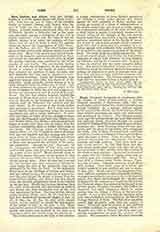

Core, Dathan, and Abiron (Heb., QRH, DTN, ABYRM), leaders of a revolt against Moses and Aaron (Num., xvi). Core was the son of Isaar, of the Caathite family of Levites; Dathan and Abiron were the sons of Eliab, the son of Phallu, of the tribe of Ruben. A fourth leader is mentioned, Hon, the son of Pheleth, likewise a Rubenite; but as the name does not again appear, a corruption of the text is rightly suspected. Core was the head of the rebellion, whence it is called the sedition of Core (Num., xvi, 49; xxvi, 9; xxvii, 3; Jude, 11), and the rebels are styled the congregation of Core (Num., xvi, 40; Ecclus., xlv, 22). The rebel faction consisted of three parties with different motives and different aims. Many of the people were not yet reconciled to the exclusive priesthood instituted at Sinai, and desired the restoration of the old order, in which the priestly functions were exercised by the oldest member of each family. The non-Aaronic Levites bore it ill that the prerogatives of the priesthood should be confined to the family of Aaron, while they occupied the position of mere servants, and they demanded that they also be admitted to exercise priestly functions. Lastly the Rubenites were aggrieved because their tribe was deprived of the leadership, which naturally should belong to it as being descended from the oldest son of Jacob. But all were animated by jealousy of the power of the house of Amram, in which the civil and religious authority was concentrated, and all aimed at its over-throw. The two first parties, however, desired the removal of Moses from power, only in so far as he was an obstacle to the realization of their claims, whereas with the Rubenites this removal was the main object. In the account of the revolt neither time nor place is mentioned. But it must have occurred shortly after leaving Sinai, when the Aaronic priesthood was still a recent institution. It probably took place at Cades, after the attempt to penetrate into the Promised Land had ended disastrously near Horma (Num., xiv, 40 sqq.), and the people had begun to realize that there was no escape from the sentence condemning them to wander forty years in the desert. The taunting words of Dathan and Abiron (Num., xvi, 13, 14) point to such a situation. Core and two hundred and fifty leading men of different tribes (cf. Num., xxvii, 3)—Dathan and Abiron for some unknown reason were not with them—went to Moses and demanded the abolition of the exclusive priesthood. “Enough for you”, they said; “all the congregation consisteth of holy ones, and the Lord is with them: why lift you up yourselves above the people of the Lord?” Moses directed them to bring their censers (fire-pans) on the morrow to offer incense with Aaron before the Lord; the Lord would choose between them. When the next day Core and his two hundred and fifty companions offered incense before the door of the tabernacle, they were destroyed by fire from the Lord. In the meanwhile Moses went to the dwellings of Dathan and Abiron, who had refused to obey his summons to appear before him, and warned the people to depart from the tents of Core, Dathan, and Abiron, lest they should share the dreadful punishment about to be inflicted on the two last. Hardly had he done speaking when the earth broke asunder and swallowed up Dathan and Abiron and their households and all the men that appertained to Core. The sons of Core did not perish, however (Num., xxvi, 10, 11), and later we find their descendants among the singers (I Par., vi, 37; II Par., xx, 19; Pss. xii, xliii, xlviii, lxxxiii, lxxxiv, lxxxvi, lxxxvii), or among the door-keepers of the temple (I Par., ix, 19; xxvi, 1, 19). Moses ordered the censers of Core and his companions to be beaten into plates and fastened to the altar as a warning to those who would usurp the priesthood.
The critical school sees in the story of this rebelliona clumsy combination of three distinct narratives; one relating a revolt under Dathan and Abiron against the civil authority of Moses; another containing an account of a rising of representatives of the people under Core, who is not a Levite, against the ecclesiastical authority of the tribe of Levi; and a third, which is merely a retouched version of the second, telling of the struggle of the non-Aaronic Levites under Core, who is now a Levite, against the exclusive priesthood vested in the family of Aaron. But it may be asked what possible object a redactor could have had in combining the narrative of a rebellion against civil authority with another having for its moral to warn against usurpation of the priesthood. The story presents nothing improbable. We need not search deeply into history to find similar examples of parties with different, or even conflicting interests, uniting for a common end. It may, it is true, be resolved into two fairly complete narratives. But many an historical account can thus be divided by using the arbitrary methods here applied, picking out sentences or parts of sentences here and there and rejecting as later additions whatever militates against division. The literary argument is too weak and too uncertain to base a theory upon it.
F. BECHTEL

